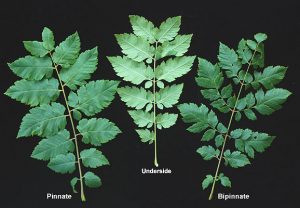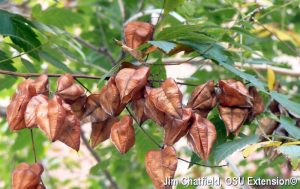Name That Tree
By Pat Dickey, Fairfax Master Gardener
 If you chose e), you are correct. Golden Raintree (Koelreuteria paniculata) is a member of the Soapberry family of flowering plants, Sapindaceae. Other trees from this family include the maple, buckeye and horse chestnut. The tree was botanically named in honor of Joseph G. Koelreuter, a professor of natural history at Karlsruhe, Germany, who was also a pioneer of plant hybridization. It is a native of the Orient: China, Korea and Japan, and was introduced in America in 1763.
If you chose e), you are correct. Golden Raintree (Koelreuteria paniculata) is a member of the Soapberry family of flowering plants, Sapindaceae. Other trees from this family include the maple, buckeye and horse chestnut. The tree was botanically named in honor of Joseph G. Koelreuter, a professor of natural history at Karlsruhe, Germany, who was also a pioneer of plant hybridization. It is a native of the Orient: China, Korea and Japan, and was introduced in America in 1763.
Golden Raintree is usually 30 feet tall and 30 feet wide at maturity. It grows well in full or partial sun and is adaptable to poor soil, pollution and drought. Many are used in urban areas near busy roadways, as is the case for the ones that were planted at our condominium along Reston Parkway.
 The foliage is pinnately compound, meaning that the leaflets are attached along an extension of the petiole called a rachis, and there is a terminal leaflet. There can be 7 to 15 leaflets. Its foliage can also be bipinnately compound and branch again, developing a second set of leaflets. Leaf color is medium to dark green. Fall color is occasionally golden yellow, but usually is chartreuse to green. Many bright yellow flowers combine to form a foot-long showy panicle, where the species name originated. Golden Raintrees have a two-week bloom period in July, and individual flowers do not open all at once. Falling blossoms may or may not resemble ‘golden rain,’ but the fallen blossoms often form an attractive carpet under the tree. Their round black seeds are produced in air-filled capsules that look like Japanese lanterns. The capsules are green in the summer and turn brown with age.
The foliage is pinnately compound, meaning that the leaflets are attached along an extension of the petiole called a rachis, and there is a terminal leaflet. There can be 7 to 15 leaflets. Its foliage can also be bipinnately compound and branch again, developing a second set of leaflets. Leaf color is medium to dark green. Fall color is occasionally golden yellow, but usually is chartreuse to green. Many bright yellow flowers combine to form a foot-long showy panicle, where the species name originated. Golden Raintrees have a two-week bloom period in July, and individual flowers do not open all at once. Falling blossoms may or may not resemble ‘golden rain,’ but the fallen blossoms often form an attractive carpet under the tree. Their round black seeds are produced in air-filled capsules that look like Japanese lanterns. The capsules are green in the summer and turn brown with age.
 The trees are single-trunked or multitrunked and quickly become asymmetrical or irregular in their growth. They become more rounded as they mature. The bark is light brown and furrowed with age. Golden Raintree is used as a specimen, as a focal point in the landscape, as a street tree and in urban areas.
The trees are single-trunked or multitrunked and quickly become asymmetrical or irregular in their growth. They become more rounded as they mature. The bark is light brown and furrowed with age. Golden Raintree is used as a specimen, as a focal point in the landscape, as a street tree and in urban areas.
There are two known cultivars. ‘September’ has flowers late in August and early September. ‘Summerburst’ is more tolerant of heat, and the foliage is glossier and darker.
Golden Raintree self-sows and is somewhat invasive in other parts of the country. It does not have many diseases or pests, but can be susceptible to trunk cankers, leaf spot and root rot. It is very sensitive to winter salt spray and extreme cold, so it is best to transplant it in the spring. It is also attractive to bees and does not live beyond 50 years.
References
Koelreuteria paniculata, Pocket Gardener, The Ohio State University
Golden rain tree, The Morton Arboretum
Koelreuteria paniculata, The Missouri Botanical Garden
Golden raintree, Arbor Day Foundation